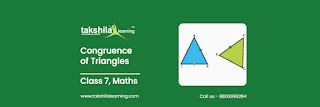Rules of congruence for triangles Class 7 Maths
Five main rules of congruency for triangles are as follows:
Side-Side-Side (or SSS):
SSS rule states that two triangles are congruent if all three sides of one triangle are comparable to the corresponding three sides of the second triangle.
Side-Angle-Side (or SAS) - rule states that two triangles are congruent if any two sides and angles included between the sides of one triangle are equivalent to the corresponding two sides and angles contained between the sides of the second triangle.
Angle-Side-Angle (or ASA) - rule states that two triangles are congruent if any two angles and sides included between the angles of one triangle are comparable to the corresponding two angles and sides included between the angles of the second triangle.
Angle-Angle-Side (or AAS): Congruent triangles have two equal angles and a non-included side, according to this rule.
AAS is analogous to ASA in that two angles and one side from two separate triangles are equivalent.
Right-Hypotenuse-Side (or RHS):
The RHS congruence rule states that two right triangles are congruent if the hypotenuse and a side of one right triangle are comparable to the hypotenuse and a side of the other right triangle.
Download Free Congruence of Triangles Worksheet for Class 7
Download the free Lines and angles worksheet for class 7

Comments
Post a Comment
Thank you we will contact ASAP.